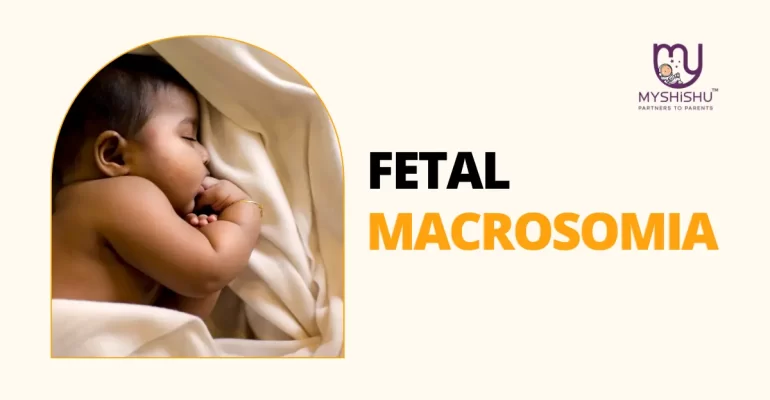Fetal Macrosomia: A Comprehensive Guide
Fetal Macrosomia: A Comprehensive Guide
Embark on a journey through the complexities of fetal macrosomia, exploring its causes and implications. This blog elucidates the multifaceted factors contributing to this condition, from maternal health conditions like gestational diabetes to genetic predispositions and gestational influences. Unveil the intricate interplay between maternal, genetic, environmental, and gestational factors shaping fetal growth patterns. Empower expectant parents and healthcare providers with knowledge and awareness to navigate this terrain, fostering maternal and fetal well-being. Join us as we unravel the mysteries of fetal macrosomia, one insight at a time.
Introduction
Fetal macrosomia, a term of curiosity and concern, captivates the attention of expecting parents and healthcare professionals alike. In this comprehensive exploration, we delve into the intricate labyrinth of fetal macrosomia causes. Defined by newborns surpassing 8 pounds and 13 ounces at birth, macrosomia poses challenges during pregnancy and childbirth. Understanding its causes is pivotal for navigating this terrain. Join us as we embark on a journey to unlock the mysteries of fetal macrosomia, shed light on its underlying factors, and empower individuals with knowledge to ensure maternal and fetal well-being.
What is fetal macrosomia?
Fetal macrosomia, a term derived from the Greek roots “macro” meaning large, and “soma” meaning body, refers to a condition in which a newborn is significantly larger than average at birth. Specifically, a baby is diagnosed with fetal macrosomia when their birth weight exceeds 8 pounds, 13 ounces (or 4,000 grams). This condition sparks intrigue and concern among expecting parents and healthcare providers due to its potential implications for pregnancy and childbirth.
While the average birth weight of a newborn typically falls within a certain range, fetal macrosomia represents an outlier on this spectrum. Babies diagnosed with macrosomia often present challenges during delivery, as their size can complicate the birthing process and increase the risk of birth injuries for both the infant and the mother.
Fetal macrosomia isn’t solely defined by weight; it also encompasses considerations of body length and head circumference. Beyond the immediate concerns surrounding delivery, macrosomia can also impact long-term health outcomes for the newborn, including an increased risk of obesity and metabolic disorders later in life.
Understanding fetal macrosomia involves unraveling the complex interplay of factors contributing to excessive fetal growth. From maternal health conditions like gestational diabetes to genetic predispositions and gestational influences, various variables converge to shape the trajectory of fetal development. By grasping the essence of fetal macrosomia, we equip ourselves with the knowledge needed to navigate this intricate landscape and promote the well-being of both mother and child.
How is delivery affected if my baby is too big?
Delivery can be significantly affected if your baby is diagnosed with fetal macrosomia, primarily due to the challenges posed by their larger size. Here are some key points to consider:
- Increased Risk of Birth Injuries: Babies with fetal macrosomia are more likely to experience birth injuries during delivery. The sheer size of the infant can make it difficult for them to pass through the birth canal, increasing the risk of shoulder dystocia—a condition where the baby’s shoulder gets stuck behind the mother’s pelvic bone. This situation can lead to complications such as nerve damage or fractures.
- Prolonged Labor: Delivering a macrosomic baby often requires a longer and more challenging labor process. The mother may experience prolonged contractions and may require interventions such as induction or augmentation to progress through labor successfully.
- Cesarean Delivery: In some cases, fetal macrosomia necessitates a cesarean section (C-section) delivery. This surgical procedure involves making an incision in the mother’s abdomen and uterus to deliver the baby. A C-section may be recommended if vaginal delivery poses significant risks to the health of the mother or baby, such as in cases of prolonged labor or shoulder dystocia.
- Postpartum Complications: Following delivery, both the mother and baby may be at an increased risk of postpartum complications. Mothers who undergo a C-section may experience longer recovery times and have a higher risk of infection or bleeding. Additionally, babies born with fetal macrosomia may face challenges such as low blood sugar levels (hypoglycemia) or respiratory issues in the immediate postpartum period.
- Medical Monitoring: Babies diagnosed with fetal macrosomia may require additional medical monitoring and care after birth to ensure their well-being. This may include monitoring blood sugar levels, assessing for signs of birth injuries, and supporting any respiratory difficulties.
In summary, delivery can be significantly affected if your baby is too big, necessitating careful management and potential interventions to ensure a safe and healthy outcome for both mother and child.

Symptoms and Causes of Fetal Macrosomia
- Increased Fundal Height: During prenatal check-ups, healthcare providers may notice that the measurement of the fundal height—the distance from the top of the mother’s uterus to the pubic bone—is larger than expected for the gestational age. This can indicate excessive fetal growth.
- Excessive Weight Gain: Expectant mothers may experience rapid or excessive weight gain during pregnancy, which can be a sign of fetal macrosomia. This weight gain may be disproportionate to the typical weight gain expected during pregnancy.
- Polyhydramnios: In some cases of fetal macrosomia, there may be an excess of amniotic fluid surrounding the baby in the uterus. This condition, known as polyhydramnios, can sometimes be detected during prenatal ultrasound examinations.
- Large Abdominal Circumference: Ultrasound imaging may reveal that the baby has a larger-than-average abdominal circumference for their gestational age. This can be an indicator of fetal macrosomia, as excessive growth often manifests in the abdomen.
- Difficulty in Feeling Fetal Movement: Due to the larger size of the baby, expectant mothers may experience difficulty in feeling fetal movements or may perceive movements as less frequent or vigorous compared to pregnancies with smaller babies.
Causes of Fetal Macrosomia:
- Maternal Diabetes: One of the primary causes of fetal macrosomia is maternal diabetes, particularly gestational diabetes mellitus (GDM). When a pregnant woman has elevated blood sugar levels, the baby may receive excess glucose, increasing fetal growth.
- Genetic Factors: Genetic predisposition can also play a role in fetal macrosomia. A family history of large birth weights or genetic factors influencing insulin resistance can increase the likelihood of a baby being born macrosomic.
- Maternal Obesity: Maternal obesity is another significant risk factor for fetal macrosomia. Excess maternal weight can contribute to higher levels of insulin and glucose in the bloodstream, which can promote fetal overgrowth.
- Advanced Maternal Age: Women who become pregnant at an older age, typically defined as 35 years or older, have a higher risk of giving birth to a macrosomic baby. Advanced maternal age is associated with metabolic changes that can influence fetal growth.
- Excessive Maternal Weight Gain: Inadequate or excessive weight gain during pregnancy can impact fetal growth. Mothers who gain weight beyond the recommended guidelines may increase the likelihood of macrosomia in their babies.
- Prolonged Gestation: Babies born after the expected due date, especially beyond 40 weeks of gestation, may experience accelerated growth in utero, leading to macrosomia.
Understanding these symptoms and causes is crucial for early detection, proper management, and minimizing potential complications associated with fetal macrosomia. Expectant mothers should maintain regular prenatal care and communicate any concerns or abnormal symptoms to their healthcare providers for timely intervention and support.
Diagnosing fetal macrosomia involves a combination of clinical assessment and specialized tests to evaluate fetal growth and assess associated risk factors. Here’s how healthcare providers typically diagnose and conduct tests for fetal macrosomia:
Diagnosis and Tests
- Clinical Assessment: Healthcare providers begin by reviewing the mother’s medical history, including any previous pregnancies, maternal health conditions such as diabetes or obesity, and family history of large birth weights. Physical examination findings, including fundal height measurements, may also provide valuable insights into fetal growth.
- Ultrasound Imaging: Ultrasonography is a cornerstone in diagnosing fetal macrosomia. During routine prenatal ultrasound examinations, healthcare providers measure various fetal parameters, including abdominal circumference, head circumference, and femur length. An estimated fetal weight above the 90th percentile for gestational age may indicate macrosomia.
- Fundal Height Measurement: Maternal fundal height—the distance from the top of the uterus to the pubic bone—is routinely measured during prenatal visits. An unusually large fundal height measurement may suggest excessive fetal growth and prompt further evaluation for fetal macrosomia.
- Maternal Glucose Testing: Given the strong association between maternal diabetes and fetal macrosomia, healthcare providers may perform glucose tolerance tests to screen for gestational diabetes mellitus (GDM). Elevated blood sugar levels in expectant mothers increase the risk of macrosomia in their babies.
Tests:
- Gestational Diabetes Screening: Glucose tolerance tests, such as the oral glucose tolerance test (OGTT) or glucose challenge test (GCT), are commonly used to screen for gestational diabetes. This involves drinking a sugary solution and measuring blood sugar levels at specific intervals to assess how the body processes glucose.
- Fetal Ultrasound: Ultrasonography is the primary imaging modality used to evaluate fetal growth and assess for macrosomia. Healthcare providers measure various fetal parameters, such as abdominal circumference, to estimate fetal weight and assess for signs of excessive growth.
- Non-Stress Test (NST): In some cases, healthcare providers may recommend a non-stress test to assess fetal well-being and monitor fetal heart rate patterns. This test involves placing sensors on the mother’s abdomen to record the baby’s heart rate in response to fetal movements.
- Biophysical Profile (BPP): A biophysical profile combines ultrasound imaging with fetal heart rate monitoring to assess fetal well-being. This test evaluates various fetal parameters, including fetal movements, muscle tone, breathing movements, and amniotic fluid volume.
- Doppler Flow Studies: Doppler flow studies assess blood flow in the umbilical cord and fetal vessels to evaluate fetal well-being and detect signs of fetal distress or compromise.
By conducting a thorough clinical assessment and utilizing specialized tests, healthcare providers can diagnose fetal macrosomia, assess associated risk factors, and formulate appropriate management and delivery plans to optimize outcomes for both mother and baby.
Management and Treatment
Managing and treating fetal macrosomia involves a multidisciplinary approach aimed at ensuring the well-being of both the mother and the baby. Here’s how healthcare providers typically address this condition:
Prenatal Management
- Regular Monitoring: Expectant mothers diagnosed with fetal macrosomia require close monitoring throughout their pregnancy. This includes regular prenatal visits to assess fetal growth, maternal blood sugar levels (if applicable), and overall maternal and fetal well-being.
- Dietary and Lifestyle Modifications: For mothers with gestational diabetes or those at risk of developing complications related to excessive fetal growth, dietary and lifestyle modifications are essential. Healthcare providers may recommend a balanced diet low in refined sugars and carbohydrates and regular physical activity to help manage blood sugar levels and promote healthy fetal development.
- Ultrasound Monitoring: Serial ultrasound examinations may be performed to monitor fetal growth and assess for signs of complications such as polyhydramnios or macrosomia-related issues. These ultrasounds help healthcare providers gauge the need for potential interventions and ensure appropriate management throughout the pregnancy.
Delivery Management
- Induction of Labor: In cases where the risks associated with continuing the pregnancy outweigh the benefits, healthcare providers may recommend inducing labor before the baby reaches full term. Induction of labor can help prevent complications related to macrosomia, such as shoulder dystocia or birth injuries, by delivering the baby before it grows too large.
- Scheduled Cesarean Section (C-section): In situations where vaginal delivery poses significant risks to the mother or baby, a scheduled cesarean section may be recommended. A C-section allows for controlled delivery, reducing the likelihood of complications associated with macrosomic births, such as shoulder dystocia or traumatic birth injuries.
- Intrapartum Management: During labor and delivery, healthcare providers closely monitor both the mother and the baby for signs of distress or complications. Continuous fetal monitoring helps identify any changes in fetal heart rate or signs of fetal distress, prompting timely interventions as needed.
Postnatal Care
- Monitoring for complications: Following delivery, both the mother and the baby undergo postnatal assessments to ensure their well-being. Babies born with fetal macrosomia may require monitoring for complications such as low blood sugar levels (hypoglycemia), respiratory issues, or birth injuries.
- Breastfeeding Support: Breastfeeding is encouraged for newborns with fetal macrosomia, as it provides optimal nutrition and helps stabilize blood sugar levels. Lactation consultants and healthcare providers offer support and guidance to mothers to ensure successful breastfeeding initiation and continuation.
- Parental Education: Parents are provided with education and resources to support the care and development of their newborn. This includes guidance on infant feeding, safe sleep practices, and recognizing signs of potential health concerns requiring medical attention.
By implementing comprehensive prenatal, delivery, and postnatal management strategies, healthcare providers strive to optimize outcomes for mothers and babies affected by fetal macrosomia. Collaboration between obstetricians, maternal-fetal medicine specialists, neonatologists, and other healthcare professionals ensures individualized care tailored to the unique needs of each patient.
Prevention
Preventing fetal macrosomia involves proactive measures to mitigate risk factors and promote maternal and fetal health. Expectant mothers can reduce the likelihood of macrosomia by maintaining a healthy lifestyle, including a balanced diet rich in fruits, vegetables, and whole grains while limiting excessive weight gain. Regular physical activity and prenatal care play crucial roles in managing maternal health conditions such as gestational diabetes and obesity, which are significant risk factors for macrosomia. Close collaboration with healthcare providers, adherence to recommended screening tests, and early intervention for maternal health conditions can help minimize the risk of fetal macrosomia and support a healthy pregnancy outcome.
When to seek the health care provider
Seeking guidance from a healthcare provider is crucial during pregnancy, especially if any concerns arise regarding fetal macrosomia. It’s essential to consult a healthcare provider if you experience symptoms such as excessive weight gain, elevated blood sugar levels, or a family history of large birth weights. Additionally, if you notice changes in fetal movement patterns, discomfort, or abnormal fundal height measurements during prenatal visits, it’s important to seek prompt medical attention. Timely communication with healthcare providers enables early detection, appropriate monitoring, and the implementation of preventive measures to safeguard maternal and fetal well-being throughout the pregnancy journey.
Additional common questions
-
Is fetal macrosomia normal?
A fetus larger than 4000 to 4500 grams (or 9 to 10 pounds) is considered macrosomic. Macrosomia is associated with an increased risk of several complications, particularly maternal and/or fetal trauma during birth and neonatal hypoglycemia and respiratory problems.
-
What genetic conditions cause macrosomia?
Causes of fetal macrosomia associated with the fetus include Beckwith-Wiedemann syndrome: This is an overgrowth condition that affects specific chromosomes. Sotos syndrome: This is a rare genetic disorder that results from a mutation in the NSD1 gene.
-
What syndromes are associated with fetal macrosomia?
Certain genetic and congenital disorders are associated with an increased risk of macrosomia, including Beckwith-Weidemann syndrome, Sotos syndrome, fragile X syndrome, and Weaver syndrome
-
What causes large gestational age?
Some babies are large because their parents are large; genetics does play a part. Birth weight may also be related to the amount of weight a mother gains during pregnancy. Excessive weight gain can translate to increased fetal weight. By far, maternal diabetes is the most common cause of LGA babies.
-
What are the risks of having a big baby?
Labor may take longer and be more likely to involve complications. There’s an increased risk of having a cesarean birth and of birth injury to you and your baby. Elective caesarean births may be recommended for: women without diabetes who are suspected of having a baby that weighs 5kg or more.
Conclusion
In conclusion, understanding fetal macrosomia and its implications is essential for expectant parents and healthcare providers alike. By recognizing the risk factors, symptoms, and diagnostic methods discussed, individuals can take proactive steps to mitigate the likelihood of macrosomia and ensure optimal maternal and fetal health. Through regular prenatal care, adherence to healthy lifestyle practices, and timely communication with healthcare providers, the journey through pregnancy can be navigated with confidence and awareness. By empowering individuals with knowledge and support, we can strive to promote safe pregnancies, minimize complications, and foster positive outcomes for both mother and baby. Here’s to a journey filled with health, happiness, and well-being.











